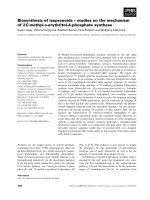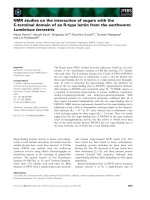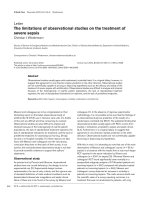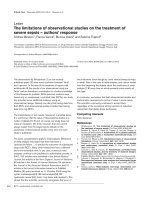Gross morphometrical studies on the brain of Kadaknath fowl in growing period
Bạn đang xem bản rút gọn của tài liệu. Xem và tải ngay bản đầy đủ của tài liệu tại đây (106.8 KB, 4 trang )
Int.J.Curr.Microbiol.App.Sci (2019) 8(9): 1201-1204
International Journal of Current Microbiology and Applied Sciences
ISSN: 2319-7706 Volume 8 Number 09 (2019)
Journal homepage:
Case Study
/>
Gross Morphometrical Studies on the Brain of
Kadaknath Fowl in Growing Period
S. K. Joshi1*, J. Udgata1, S. Sathapathy2 and S. K. Sahu2
1
2
Krishi Vigyan Kendra, OUAT, Jharsuguda – 768202, India
Department of Anatomy and Histology, CVSc. & A.H., OUAT, Bhubaneswar – 751003, India
*Corresponding author
ABSTRACT
Keywords
Brain, gross,
grower, Kadaknath,
morphometry
Article Info
Accepted:
12 August 2019
Available Online:
10 September 2019
The present gross morphometrical study was carried out on the brain of six healthy
birds of Kadaknath Fowl in growing period (7 weeks to 16 weeks). The birds were
procured from the Central Poultry Development Organization (CPDO), Eastern
Region, Bhubaneswar and the research work was conducted at Krishi Vigyan
Kendra, Jharsuguda, OUAT. It was found that the brain of Kadaknath fowl
subdivided into cerebrum, cerebellum and medulla oblongata. It was found that
the average maximum length and width of the brain were found to be (3.2±0.124)
cm and (2.9±0.091) cm respectively. The right olfactory bulb was longer and
wider than the left one. Similarly, the right optic lobe was larger than the left one.
The average length of longitudinal intercerebral groove was measured as
(1.9±0.025) cm. The average width of longitudinal intercerebral groove was
uniform at cranial, middle and caudal parts and found to be (0.2±0.001) cm.
Further, the average perimeter of middle vermis lobe of cerebellum was measured
as (2.6±0.194) cm. The present baseline data on various important parameters of
brain of Kadaknath fowl in grower period would pave the way for further research
in this field.
Introduction
Poultry production in India has taken a
quantum leap in the last four decades,
emerging from an unscientific farming
practice to commercial production system
with state-of-the art technological inventions
(Tamilselvan et al., 2018). There is a
tremendous development in the poultry
industry in last few decades, but little attention
has been paid for indigenous chicken, due to
its poor producing ability (Kumar et al.,
2018). Total poultry population of India was
estimated to be 700 million, out of which
about 10 to 15% were indigenous or native
breeds. There are about 20 indigenous
breeds/varieties of chicken found in India.
Backyard poultry farming is a part and parcel
of typical rural/tribal household, touching
social, cultural and economic aspects in India.
Need of conservation and improvement of
animal genetic resources has been globally
1201
Int.J.Curr.Microbiol.App.Sci (2019) 8(9): 1201-1204
accepted. Out of many indigenous poultry
breeds, one well known breed named as
Kadaknath or Kalamasi meaning the fowl
having black flesh. Kadaknath is an important
indigenous breed of poultry inhabitating vast
areas of Western Madhya Pradesh mainly the
Jhabua (Bendapudi, 2016) and Dhar Districts
and adjoining areas of Gujarat and Rajasthan.
There are three main varieties of Kadaknath
breed. They are Jet black, pencilled and
Golden Kadaknath (Parmar, 2003). The Jet
black adult males and females are black in
colour, the Golden adult male and females are
basically black in colour with Golden feathers
on head and neck, whereas in Pencilled variety
adult male and female plumage is black with
white feathers on neck. It is locally known as
"Kalamasi" as it is having black flesh
(Mahanta et al., 2018). The peculiarity of this
breed is that most of the internal organs show
the characteristic black pigmentation which is
more pronounced in trachea, thoracic and
abdominal air sacs, gonads, elastic arteries, at
the base of the heart and mesentery. Varying
degree of blackish colouration is also found in
the skeletal muscles, tendons, nerves,
meninges, brain and bone marrow (Das et al.,
2018). Avian brain study is an emerging field
in present era of biological studies. The
present gross morphometrical study was
carried out on the brain of Kadaknath fowl in
growing period (7 weeks to 16 weeks) to
establish a baseline data for this breed for
future research.
Materials and Methods
The Kadaknath chicks were procured from the
Central Poultry Development Organization
(CPDO), Bhubaneswar. The chicks were
reared at KVK, Jharsuguda, OUAT and six
healthy birds were selected from grower stage
(7 weeks to 16 weeks) to study the gross
morphometrical features of brain. The head of
the birds under study were carefully separated
at the level of second cervical vertebrae
(Panigrahy et al., 2017). The cranial cavity
was cut open very carefully with the help of
scissors, forceps and scalpel. Then nasal bones
and temporal bones were severed rostrally and
laterally by the help of bone cutter. These
separations were done up to the level of base
of skull. All cranial nerve attachments were
cut gently to separate the intact brain from insitu after detaching it from the spinal cord at
the level of foramen magnum. The intact brain
was removed from the cranial cavity after
detaching it from the spinal cord at the level of
foramen magnum. Then the meninges of brain
were separated. After the collection, the intact
whole brain samples were cleaned (washed) in
normal
saline
solution
and
detail
morphometrical studies were undertaken. The
weight of whole brain and its different
components were taken in digital weighing
balance. Further, the volumes were measured
by water displacement method. The
measurements of different parameters of brain
were taken with the help of scale, thread and
digital weighing balance. The different
biometrical parameters of brain measured
were subjected to routine statistical analysis as
per standard technique given by Snedecor and
Cochran (1994).
Results and Discussion
The average maximum length of the brain
(measured from cranial end of cerebral
hemisphere to caudal end of medulla
oblongata) was found to be (3.2±0.124) cm.
The average maximum width of the brain
(highest distance between the lateral boarders
of cerebral hemispheres) was found to be
(2.9±0.091) cm. The average cranio-caudal
lengths of left and right cerebral hemispheres
were found to be (2.1±0.223) cm and
(2.0±0.112) cm respectively. The average
widths of left cerebral hemisphere at cranial,
middle and caudal parts were measured as
(0.6±0.021) cm, (1.6±0.008) cm and
(0.9±0.132) cm respectively. Similarly,
1202
Int.J.Curr.Microbiol.App.Sci (2019) 8(9): 1201-1204
average widths of right cerebral hemisphere at
cranial, middle and caudal parts were
measured as (0.5±0.015) cm, (1.2±0.023) cm
and (1.1±0.019) cm respectively. Further, the
average thickness of left cerebral hemisphere
at cranial, middle and caudal parts was found
to be (0.3±0.005) cm, (1.0±0.008) cm and
(0.7±0.006) cm respectively. Similarly, the
average thickness of right cerebral hemisphere
at cranial, middle and caudal parts was found
to be (0.6±0.002) cm, (1.1±0.008) cm and
(0.9±0.010) cm respectively. So, right cerebral
hemisphere was comparatively thicker than
the left one. The average perimeters of left and
right cerebral hemispheres were found to be
(4.5±0.312) cm and (4.8±0.229) cm
respectively. The average length of
longitudinal
intercerebral
groove
was
measured as (1.9±0.025) cm. The average
width of longitudinal intercerebral groove was
uniform at cranial, middle and caudal parts
and found to be (0.2±0.001) cm.
The average cranio-caudal lengths of left and
right olfactory bulbs were found to be
(0.4±0.001) cm and (0.6±0.002) cm
respectively. The average widths of left
olfactory bulb at cranial, middle and caudal
parts were measured as (0.1±0.001) cm,
(0.2±0.001) cm and (0.1±0.001) cm
respectively. Similarly, the average widths of
right olfactory bulb at cranial, middle and
caudal parts were measured as (0.3±0.002)
cm, (0.5±0.001) cm and (0.3±0.001) cm
respectively. This suggested that the right
olfactory bulb was longer and wider than the
left one.
The average cranio-caudal diameters of left
and right optic lobes were found to be
(1.0±0.010) cm and (1.1±0.008) cm
respectively. The average transverse diameters
of left optic lobe at cranial, middle and caudal
parts were measured as (0.4±0.001) cm,
(0.9±0.003) cm and (0.5±0.002) cm
respectively. Similarly, average transverse
diameters of right optic lobe at cranial, middle
and caudal parts were measured as
(0.5±0.001) cm, (1.0±0.012) cm and
(0.5±0.007) cm respectively. Further, the
average perimeters of left and right optic lobes
were measured as (1.7±0.339) cm and
(2.0±0.226) cm respectively. This suggested
that the right optic lobe was larger than the left
one.
The average length of middle vermis lobe of
cerebellum was found to be (0.9±0.017) cm.
The average widths of middle vermis lobe of
cerebellum at cranial, middle and caudal parts
were measured as (0.6±0.003) cm, (0.8±0.002)
cm and (0.5±0.001) cm respectively.
Similarly, the average thickness of middle
vermis lobe of cerebellum at cranial, middle
and caudal parts was found to be (0.5±0.003)
cm, (0.3±0.002) cm and (0.2±0.001) cm
respectively. Further, the average perimeter of
this lobe of cerebellum was measured as
(2.6±0.194) cm. The average maximum width
of transverse groove located between the
cerebrum and cerebellum was found to be
(2.6±0.125) cm.
Study on avian brain will usher a path to the
neuro-anatomists to investigate general
principles of the nervous system in respect to
development behavior, physiology, anatomy
and molecular biology. The avian models can
be used to decipher many unknown facts
about neuronal mechanism underlying various
cognitive functions such as memory, learning,
consciousness and attention. The gross
morphometry of brain of Kadaknath fowl at
grower period was successfully studied here.
The baseline data developed could be useful
for further research.
Acknowledgement
The Authors are very much grateful to the
Director, CPDO, Bhubaneswar for providing
the birds to rear and carry out the research
1203
Int.J.Curr.Microbiol.App.Sci (2019) 8(9): 1201-1204
work in KVK, Jharsuguda, OUAT. The
Authors appreciate the co-operation of the
faculties and students of Department of
Anatomy and Histology, CVSc. & A.H.,
OUAT, Bhubaneswar for their necessary
inputs.
References
Bendapudi, R.K. 2016. Strengthening
Backyard Poultry Rearing: Approach
and results from a pilot project in
Jhabua, Madhya Pradesh. South Asia
Pro Poor Livestock Policy Programme;
A joint initiative of National Dairy
Development Board (India) and Food
and Agriculture Organisation of the
United Nations.
Das, S., Dhote, B.S., Singh, G.K. and Sinha,
S. 2017. Histomorphological and
micrometrical
studies
on
the
proventriculus of Kadaknath fowl.
Journal of Entomology and Zoology
Studies. 5(3):1560-1564.
Kumar. A., Tigga, R., Bharti, A. and Kumar,
R. 2018. Role of Krishi Vigyan
Kendras
in
Conservation
and
Promotion of Kadaknath Poultry Breed
through
Backyard
Rearing for
Livelihood Security of Tribal Farmers
in Chhattisgarh. International Journal
of Current Microbiology and Applied
Sciences. Special Issue 7: 1194-1200.
Mahanta, D., Mrigesh, M., Sathapathy, S.,
Tamilselvan, S., Pandit, K. and Nath,
S. 2018. Gross and morphometrical
studies on the thymus, spleen and
bursa of Fabricius of day old
Kadaknath
chick.
Journal
of
Entomology and Zoology Studies.
6(3):555-558.
Panigrahy, K.K., Behera, K., Mandal, A.K.,
Sethy, K., Panda, S., Mishra, S.P.,
Singh, A.K. and Sahu, S.K. 2017.
Gross morphology and encephalization
quotient of brain in male and female
Vanaraja chickens at different ages.
Explor Anim Med Res. 7(1): 28-32.
Parmar, S.N.S. 2003. Characterization of
Kadaknath breed of Poultry (Famous
Black Bird of Jhabua). Technical
Bullettin, DRS, JNKVV, Jabalpur
(MP).
Tamilselvan, S., Dhote, B.S., Singh, I.,
Mrigesh, M., Sathapathy, S., Mahanta,
D. 2018. Gross morphology of testes
and gonadosomatic index (GSI) of
guinea fowl (Numida meleagris).
Journal of Entomology and Zoology
Studies. 6(3):156-159.
Snedecor, G.W. and Cochran, W.G. 1994. In
Statistical methods 8th Edn. Oxford
and IBH Publishing House, Calcutta.
How to cite this article:
Joshi, S. K., J. Udgata, S. Sathapathy and Sahu, S. K. 2019. Gross Morphometrical Studies on
the Brain of Kadaknath Fowl in Growing Period. Int.J.Curr.Microbiol.App.Sci. 8(09): 12011204. doi: />
1204









